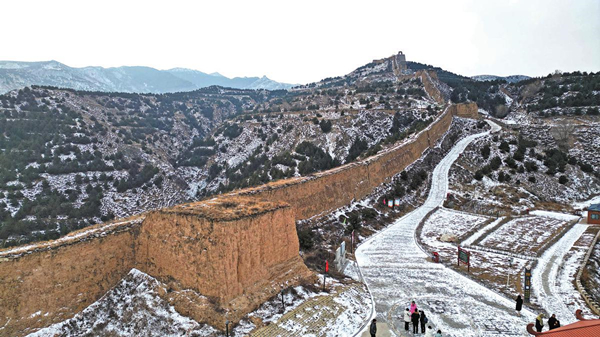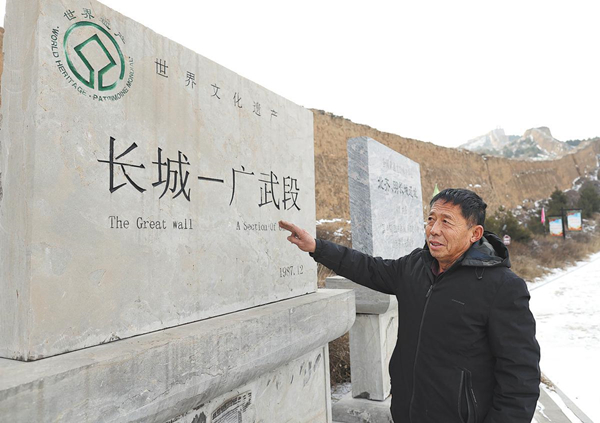Great Wall protectors watch over ancient cultural heritage
Locals foster lifelong connection to monumental structure they grew up around

The Guangwu section of the Great Wall stretches across the ridgeline in Shanyin county, Shanxi province. ZHU XINGXIN/CHINA DAILY
On a frosty morning in the depths of winter in northern China, 65-year-old Yin Chengwu patrols along the Guangwu section of the Great Wall of China in Shanxi province. "I have been safeguarding this part of the Great Wall for 46 years and have developed a deep emotional bond with this precious legacy left by our ancestors," Yin told China Daily.
Born at the foot of the Great Wall, Yin grew up listening to his father's tales of the goliath structure, fostering a lifelong connection to the monument.
"The Guangwu section is not only a fine example of the Ming Great Wall in Shanxi, but is also a well-protected part among the Great Wall sections across the country," Yin said.
The Great Wall was an ancient Chinese military defense project that played a crucial role in maintaining border stability, facilitating agricultural development, protecting communication routes, and supporting trade and travel. Throughout history, the total length of the Great Wall exceeded 21,000 kilometers, spanning 15 provinces, autonomous regions and municipalities.
Located outside Yanmen Pass in Shanyin county, the Guangwu Great Wall was constructed in 1374 during the Ming Dynasty (1368-1644). Rising 6 to 8 meters and with a width of 5 meters, the wall meanders along mountain ridges, undulating with the natural contours like the spine of a snaking dragon.

Yin Chengwu speaks about the Guangwu section of the Great Wall of China, which he has been safeguarding for 46 years. ZHU XINGXIN/CHINA DAILY
Yin said that the entire wall was built with bricks and stone, with 16 watchtowers, of which five are well-preserved.
"It occupied a strategically important position, serving as a vital component of the Ming Dynasty's military defense system against threats from the north," Yin said.
Among its unique features is the iconic "Moon Gate", a renowned landmark of the Guangwu Great Wall. In October 2016, a fierce storm caused part of the gate to collapse. Four years later, the gate was restored, and continues to attract tourists.
Prior to the 1960s, Yin said that many bricks from the Great Wall were taken by nearby villagers, causing immeasurable damage to the historical site.
In 1979, Yin became a guardian of the Guangwu Great Wall, patrolling daily to deter villagers from taking any bricks. In the 1980s, he measured the wall using a spool of rope and a tape measure, with the results differing by only 5 meters compared to satellite measurements.
"I cannot be separated from the Great Wall in this lifetime," he said.
In 2019, the New Guangwu Ming Great Wall was designated as a State-protected cultural relic by the State Council. It remains a crucial part of the Guangwu Great Wall National Cultural Park.
"We are currently enhancing infrastructure development to establish a complete Great Wall cultural industry chain," Yin said. "It will not only showcase our rich historical and cultural heritage but also drive the development of the cultural industry."
Inspired by Yin, many villagers, including Hao Zhonghua, have joined the ranks of Great Wall protectors.
"To safeguard the Great Wall is to safeguard our homeland," Hao said. Born in New Guangwu village, 43-year-old Hao was hired as a cultural preservation worker in 2015.
Under Hao's influence, his wife, Huo Chunling, also joined the ranks of Great Wall cultural preservation workers.
Contact the writers at zhuxingxin@chinadaily.com.cn



